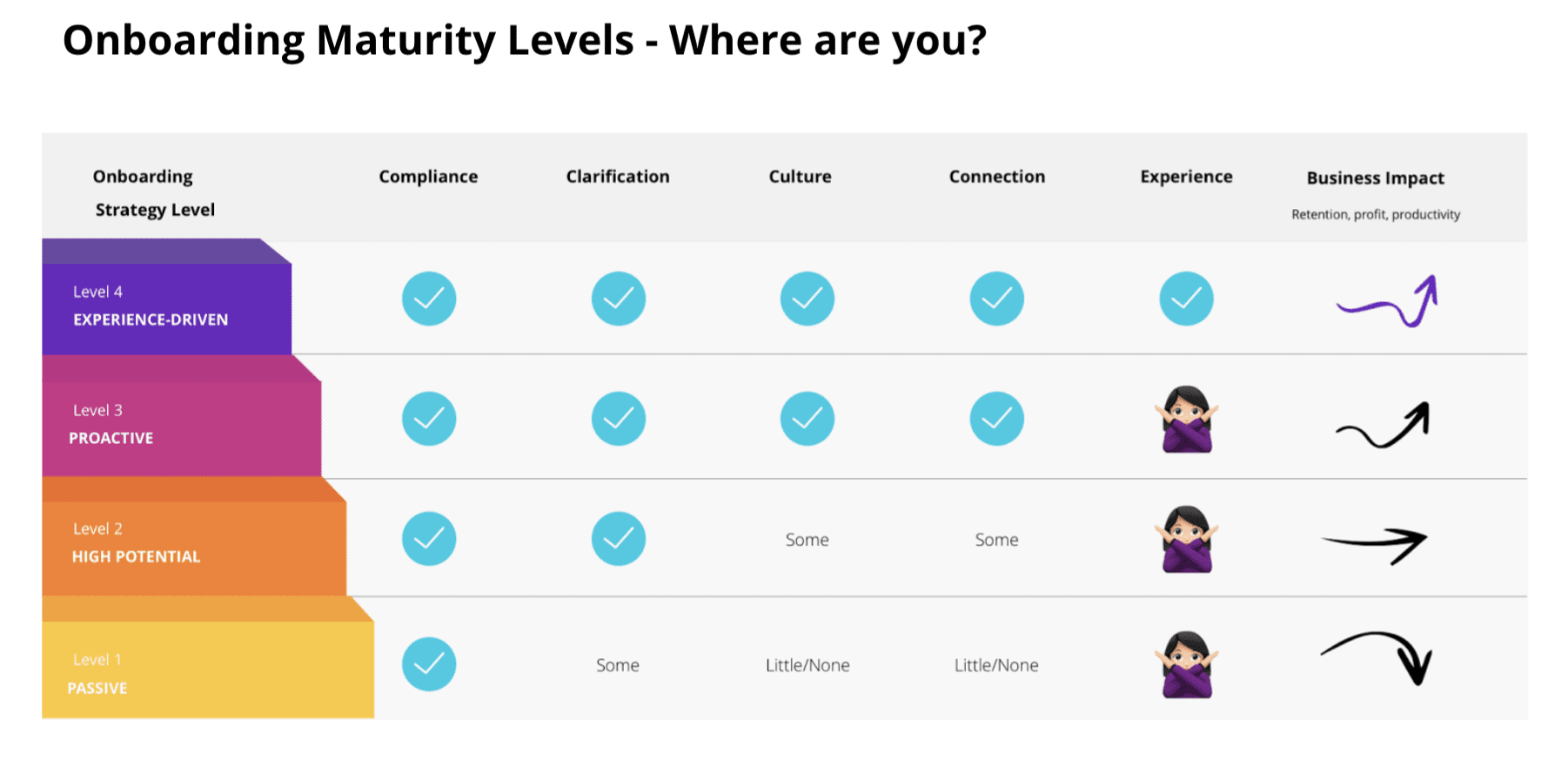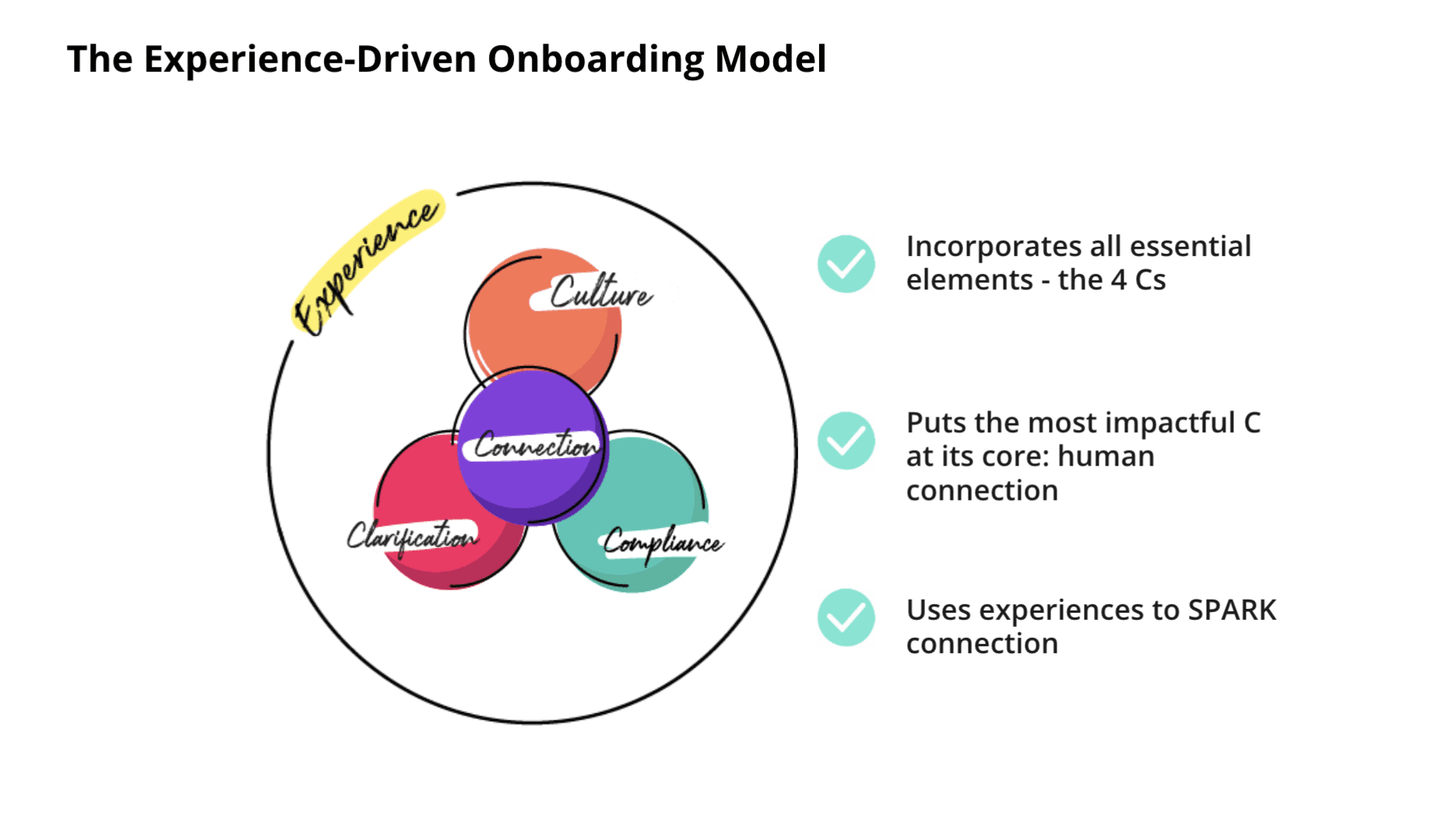The Four C’s of Onboarding. And One E that Rules Them All
In 2010, workplace relationships expert Dr. Talya Bauer wrote a report for SHRM laying out what’s today recognized as a definitive model of onboarding: the Four C’s.
The Four C’s are very close to our hearts here at Enboarder and underpin our entire philosophy, so let’s dive into the model. Then we’ll show you how we’ve built on the approach, adding an extra E that powers major business impact.
Let’s go.
The Four C’s – the building blocks of onboarding
For Bauer, onboarding has four fundamental building blocks:
- Compliance – the most basic level. Forms, health and safety, compliance, legal bumf. The administrative stuff that nobody loves but does need doing.
- Clarification – ensuring new hires clearly understand the job and what’s needed to excel. And the reverse, ensuring the organization clearly understands what new hires are here to do.
- Culture – your organizational norms. Your politics, goals and unique language. What makes the business tick, formally and between the lines.
- Connection – the interpersonal relationships and communication network everyone (hopefully!) builds at work. Friends, advisors, confidantes: your people’s tribe.

How well organizations perform against these Four C’s determines their overall strategic level of onboarding. More building blocks = a more robust house.
Let’s look at the three strategic onboarding levels that Bauer outlines.
1 – Passive Onboarding
This is the most basic level of onboarding, and includes a heavy focus on the first C, Compliance. There may be some basic Clarification, but Culture and Connection aren’t addressed in any organized, focused way. As Bauer puts it, “Passive Onboarding can be functional, but it is certainly unsystematic.”
Bauer says 30% of large, medium and small organizations fall into this level (or fell into, in 2010. There’s definitely been some evolution since, although our own research shows less progress has been made than is ideal.)
2 – High Potential Onboarding
This level of onboarding probably covers elements of all Four C’s, but coverage is patchy at best. As Bauer puts it, “compliance and clarification are well covered […] and some culture and connection mechanisms are in place”.
Bauer says 50% of organizations sit here.
3 – Proactive Onboarding
“If your firm is systematically organizing onboarding with a strategic human resource management approach, you are at Level 3”, Bauer says. That is, you have an organised strategy for embedding each of the Four C’s, to best set your new hires up for success.
Only 20% of organisations reach this level, Bauer says.

This Four C’s model has been massively influential for our own philosophy of onboarding, but our experience has also proved that all C’s aren’t made equal. There’s actually one C that everything else hinges on – Connection.
And we’ve seen time and again (for a whole heap of customers who’re achieving amazing results) that when you place Connection at the heart of your onboarding, the business results skyrocket.
Business results like:
- Shorter time-to-productivity
- Increased first-year retention
- Dramatic turnover cost savings
- Improved quality-of-hire
- Increased employee engagement
- Slashed compliance risk profile
That’s why we introduced a fourth strategic level of onboarding – Experience-Driven onboarding.

In this model, your onboarding function systematically incorporates all Four C’s but puts the most powerful C – Connection – at its core by using Experience as the delivery mechanism.

Using this model, Experience wraps around the Four C’s – becoming a strategic lever for better business outcomes.
In our recent virtual onboarding webinar, we held an informal poll to see where most people felt their organization fell on this four-stage maturity model. Of the attendees we asked:
- 44% felt they’re level two
- 34% felt they’re level three
- 8% felt they’re level four (full disclosure: they’re the ones using Enboarder 👀)
It’s fantastic to see a movement away from basic functional onboarding that focuses only on compliance. But there’s still room for improvement. We’d love to see that 8% creep into the high double-digits (or why not triple digit? The sky’s the limit!)
Next steps: Put your experience-tinted glasses on
It’s totally OK if your onboarding hovers around level one or two right now. Don’t let perfection get in the way of progress. There’s no end limit on how amazing it can be, which can feel overwhelming. Turn experience into the lens you filter all your onboarding decisions through, whatever maturity stage you’re at.
For example, how could you improve the experience of delivering health and safety information? Could you make reading and signing forms easier? How could you better bring your culture to life for new hires?
By focusing on how you make new hires feel, you create a powerful, empathetic onboarding experience they’ll remember forever.
Check out how Enboarder can help improve the process with their automated onboarding solution.